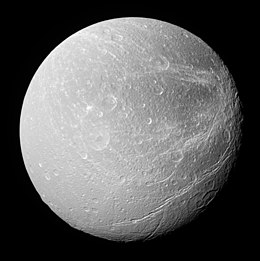Dione (moon)

Dione photographed in natural light by the
Cassini spacecraft in 2008 |
|
| Discovery | |
|---|---|
| Discovered by | Giovanni Cassini |
| Discovery date | March 21, 1684 |
| Designations | |
| Saturn IV | |
| Adjectives | Dionean |
| Orbital characteristics | |
| 377396 km | |
| Eccentricity | 0.0022 |
| 2.736915 d | |
| Inclination | 0.019° (to Saturn's equator) |
| Satellite of | Saturn |
| Physical characteristics | |
| Dimensions | 1128.8 × 1122.6 × 1119.2 km |
|
Mean radius
|
561.4±0.4 km |
| 3964776.51 km2 | |
| Mass | (1.095452±0.000168)×1021 kg (3.28×10−4 Earths) |
|
Mean density
|
1.478±0.003 g/cm³ |
| 0.232 m/s2 | |
| 0.51 km/s | |
|
2.736915 d (synchronous) |
|
| zero | |
| Albedo | 0.998±0.004 (geometric) |
| Temperature | 87 K (−186°C) |
| 10.4 | |
Dione (/daɪˈoʊni/ dy-OH-nee; Greek: Διώνη) is a moon of Saturn. It was discovered by Italian astronomer Giovanni Domenico Cassini in 1684. It is named after the Titaness Dione of Greek mythology. It is also designated Saturn IV.
Giovanni Domenico Cassini named the four moons he discovered (Tethys, Dione, Rhea and Iapetus) Sidera Lodoicea ("the stars of Louis") to honor king Louis XIV. Cassini found Dione in 1684 using a large aerial telescope he set up on the grounds of the Paris Observatory. The satellites of Saturn were not named until 1847, when William Herschel's son John Herschel published Results of Astronomical Observations made at the Cape of Good Hope, suggesting that the names of the Titans (sisters and brothers of Cronus) be used.
Dione orbits Saturn with a semimajor axis about 2% less than that of the Moon. However, reflecting Saturn's greater mass, Dione's orbital period is one tenth that of the Moon. Dione is currently in a 1:2 mean-motion orbital resonance with moon Enceladus, completing one orbit of Saturn for every two orbits completed by Enceladus. This resonance maintains Enceladus's orbital eccentricity (0.0047), providing a source of heat for Enceladus's extensive geological activity, which shows up most dramatically in its cryovolcanic geyser-like jets. The resonance also maintains a smaller eccentricity in Dione's orbit (0.0022), tidally heating it as well.
...
Wikipedia
